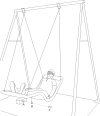Measuring threshold and latency of motion perception on a swinging bed
- PMID: 34242212
- PMCID: PMC8270192
- DOI: 10.1371/journal.pone.0252914
Measuring threshold and latency of motion perception on a swinging bed
Abstract
Introduction: Our objective was to develop and to evaluate a system to measure latency and threshold of pendular motion perception based on a swinging bed.
Materials and methods: This prospective study included 30 healthy adults (age: 32 ± 12 years). All subjects were tested twice with a 10 min. interval. A second trial was conducted 2 to 15 days after. A rehabilitation swinging bed was connected to an electronic device emitting a beep at the beginning of each oscillation phase with an adjustable time lag. Subjects were blindfolded and auditory cues other than the beep were minimized. The acceleration threshold was measured by letting the bed oscillate freely until a natural break and asking the patient when he did not perceive any motion. The perception latency was determined by asking the patient to indicate whether the beep and the peak of each oscillation were synchronous. The time lag between sound and peak of the head position was swept from -750 to +750 ms by 50 ms increments.
Results: The mean acceleration threshold was 9.2±4.60 cm/s2. The range width of the synchronous perception interval was estimated as 535±190 ms. The point of subjective synchronicity defined as the center of this interval was -195±106 ms (n = 30). The test-retest evaluation in the same trial showed an acceptable reproducibility for the acceleration threshold and good to excellent for all parameters related to sound-movement latency.
Conclusion: Swinging bed combined to sound stimulation can provide reproducible information on movement perception in a simple and non-invasive manner with highly reproducible results.
Conflict of interest statement
The authors have declared that no competing interests exist.
Figures



References
MeSH terms
LinkOut - more resources
Full Text Sources

